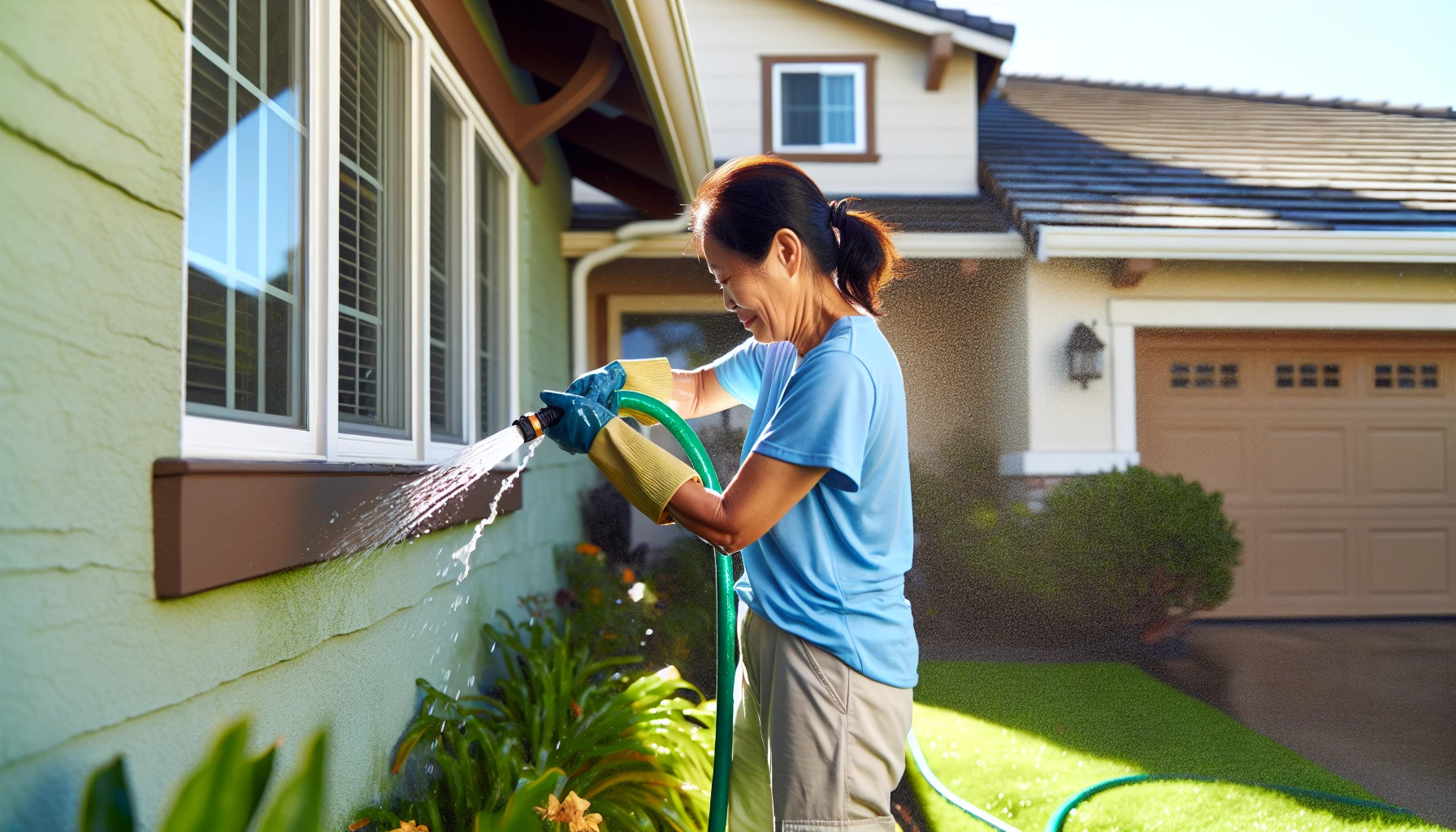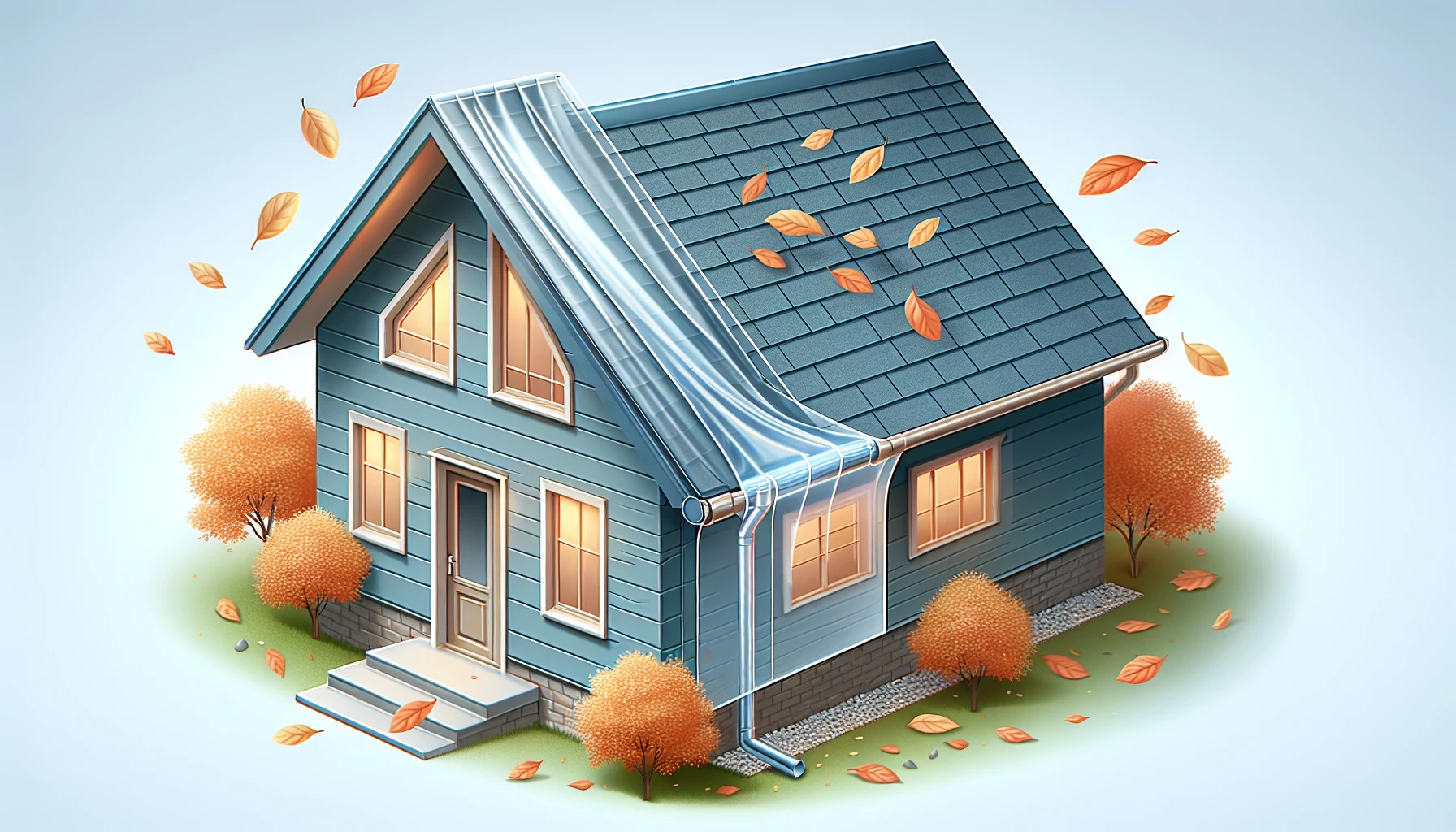Gutters play a vital role in protecting your home from water damage, but they can quickly become clogged with leaves, twigs, and other debris, leading to gutter clogs. To keep your gutters functioning efficiently, it’s important to know how to recognize clogs, understand their common causes, and learn effective techniques for unclogging and maintaining your gutter system. By following the guidance in this blog post, you’ll be well on your way to preventing costly damages and ensuring your gutters remain clog-free.
Key Takeaways
- Recognize gutter clogs by looking for signs such as overflowing rainwater and sagging gutters.
- Utilize preventative measures like regular inspections, cleaning, and the implementation of gutter guards or screens to keep your gutters clog-free.
- If it is too difficult to clean from the ground, call in professional help for a safe and efficient job.
Recognizing Gutter Clogs

Recognizing the signs of a clogged gutter helps you to act promptly. Overflowing rainwater, pooling water around your home’s foundation, and sagging gutters are all indicators that your gutter system may be clogged. Clogged downspouts can lead to potential damage to your home. Timely unclogging of gutters helps you avert damage to your landscaping, home exterior, gutters, and foundation caused by downspout clogs.
If you’re unable to identify the location of a gutter clog, it may be hidden in an underground pipe or downspout hole, especially if your downspouts descend below ground level. A clogged downspout can lead to bigger problems, such as water damage, structural damage, or pest infestations. Regular cleaning and inspection can help you catch and resolve these issues before they escalate.
The Usual Suspects: Common Causes of Gutter Clogs
The primary causes of gutter clogs include leaves, twigs, and debris accumulation, which can impede the natural flow of water. Poorly designed or improperly installed gutter downspouts, and the presence of insects or pests can also contribute to clogged gutters. If left untreated, clogs can lead to leaks and potentially foundation issues.
Seasonal factors, such as falling leaves and limbs during autumn, can easily accumulate in the gutters and cause blockages. Heavy rainstorms can also cause water to overflow and further obstruct the gutters. Regular cleaning and maintenance of gutters using suitable tools like a handheld drum auger helps prevent clogs due to seasonal factors.
Seasonal Factors
In addition to falling leaves and limbs in autumn, spring pollen and blossoms can accumulate in the gutters, along with other debris, resulting in clogged gutters and impeding proper drainage. Summer and winter storms can also deposit debris into your gutters, increasing the likelihood of clogs. Consistent cleaning of gutters during these seasons helps to prevent clogs and maintain proper water flows.
Taking preventive measures, such as installing gutter guards or screens, can minimize the impact of seasonal factors on gutter clogs. These barriers help to keep debris out of your gutters while allowing water to flow through, reducing the need for frequent gutter cleaning and maintenance.
Improper Gutter Installation
Improper gutter installation can cause clogs and other issues. If the gutters and downspouts are not installed correctly, it can impede the flow of water, leading to debris accumulation and clogs. Additionally, improper downspout installation can also contribute to clogs.
Incorrect gutter placement, slope, or size can lead to clogging as well. An incorrect slope in gutter installation can result in debris and standing water accumulating in the gutters, causing blockages. Ensuring proper installation of gutters helps to prevent these problems.
Essential Tools for Unclogging Gutters
Equipping yourself with the right tools is necessary for effectively unclogging your gutter system. Here are the essential tools you will need:
- Water hose
- Spray nozzle
- Downspout cleaning tools
- Protective gloves
- Safety eyewear
- Scooping tool
- Stable ladder
These tools will ensure your safety and help you get the job done efficiently.
When choosing the right tool for unclogging gutters, consider options such as a plumbing snake, leaf blower, or pressure washer, depending on the severity of the clog and your personal preferences. Each tool has its advantages and can help you effectively remove debris and clear clogs from your gutter system.
Safety Gear
Safety should always be a top priority when working on your gutters. Wearing protective gloves and safety glasses can help shield you from any potential debris or sharp objects while unclogging gutters. Along with gloves and safety glasses, using a sturdy ladder and adhering to the manufacturer’s instructions when using tools like a pressure washer or leaf blower is necessary.
Remember that it’s always better to err on the side of caution when working at height or with unfamiliar tools. If you’re unsure of your ability to safely clean your gutters, it’s best to seek professional help to avoid any potential accidents or injuries.
Choosing the Right Tool for the Job
The right tool for unclogging your gutters will depend on the specific situation and your personal preferences. A leaf blower is an effective option for clearing out gutters and can be easily used from the ground with a specialized nozzle to direct the airflow into the gutters. A plumbing snake, on the other hand, can be inserted into the downspout and rotated to effectively loosen and break up the debris causing the clog.
Lastly, here are some tools that can help with gutter maintenance:
- A ladder with stabilizers to safely reach your gutters
- A gutter scoop or trowel to remove debris
- A garden hose with a high-pressure nozzle to flush out the gutters
- A pressure washer with a gutter cleaner attachment to remove stubborn clogs and clean your gutters thoroughly
Before deciding on a tool, consider the severity of the clog, the height of your gutters, and your comfort level with using different tools. Remember that safety is always a priority, and adhering to the manufacturer’s guidelines when using any tool for gutter maintenance is necessary.
Step-by-Step Guide to Unclogging Your Gutters

Once you’ve gathered the necessary tools and safety gear, it’s time to tackle the clogged gutters. Here’s how:
- Disconnect the downspout extension from the bottom. This will expose the vertical part of the spout.
- Remove any large debris from the gutters by hand or with a small garden trowel.
- Use a hose, pressure washer, or leaf blower to flush the gutters and downspouts with water, ensuring the system is clear and functioning optimally.
If water still backs up into the gutter after cleaning, try loosening any debris in the downspout by banging on it or using other tools. Being persistent and patient while unclogging gutters helps to prevent damage to your home’s foundation and avoid other potential issues. To effectively unclog a gutter downspout, ensure you have the proper tools and follow safety precautions.
Clearing Gutter Debris

Effectively removing debris is key to maintaining a functional gutter system. A gutter scoop or puncture-resistant work gloves can be used to remove leaves, twigs, and other debris from the gutters. Once the debris has been removed, use a garden hose to flush the gutters and downspouts to clear out any remaining debris and ensure proper water flow.
In addition to manual debris removal, a leaf blower with a specialized nozzle can be utilized to blow the debris out of the gutters efficiently and quickly. Be sure to pay special attention to the downspout area, as debris can often accumulate there, and use the leaf blower to blow out any clogs or blockages.
Flushing the Gutter System
Once the debris has been cleared from your gutters, you should flush the gutter system. Here’s how:
- Position yourself at one end of the gutter system.
- Spray the gutters and downspouts down with a garden hose to flush everything out
- Start spraying water into the gutter, moving along the length of the gutter.
- Allow the high-pressure stream of water to flush out any remaining debris.
This will ensure that your gutter system is clear and functioning optimally.
Pay special attention to the gutter downspout and downspout elbows, as they can often become clogged. If you encounter stubborn clogs, consider using a pressure washer with a gutter cleaner attachment to thoroughly clean your gutters and remove any remaining debris. Always exercise caution when using a pressure washer on a ladder and adhere to safety guidelines.
Preventative Measures: Keeping Your Gutters Clog-Free
Taking preventative measures helps to minimize the risk of gutter clogs and their associated problems. Regular inspections and cleaning, as well as the implementation of gutter guards or screens, can help keep your gutters clog-free. It is recommended to inspect and clean your gutters every six months, preferably in the fall and spring.
During routine inspections, look for signs that your gutters need cleaning, such as gutters overflowing, water not draining through the downspout, or sagging gutters. By addressing these issues promptly, you can prevent damage to your landscaping, home exterior, gutters, and foundation caused by downspout clogs.
Routine Inspection and Cleaning
Regularly inspecting and cleaning your gutters is key to maintaining their functionality and preventing clogs. Inspecting and cleaning your gutters in the fall and spring can help you catch and resolve issues before they escalate into bigger problems, such as water damage, structural damage, or pest infestations.
A comprehensive gutter inspection should include assessing gutters from the ground, removing debris from gutters, and examining gutter damage and gutter aprons for gaps. Maintaining vigilance and proactivity with gutter maintenance can help avoid costly damages and keep your gutters clog-free.
Gutter Guards and Screens

Gutter guards and screens serve as a physical barrier that prevents leaves, twigs, and other debris from entering the gutters while allowing water to flow through. These barriers come in various forms, including metal or plastic screens, perforated aluminum covers, and micro-mesh gutter guards.
Installing gutter guards or screens can provide several benefits, including:
- Minimizing the risk of clogs
- Preventing water damage
- Blocking pests and debris
- Improving gutter efficiency
- Enhancing the aesthetics of your home
While gutter guards or screens may not completely eliminate the need for gutter cleaning, they can significantly reduce the frequency and make the process easier and more manageable.
When to Call in the Professionals
Many homeowners manage to unclog their gutters using the techniques discussed in this post, but there might be situations where hiring professional gutter cleaners is advisable. If attempting to clean gutters from the ground is not feasible or would require an excessive amount of time, it might be beneficial to enlist the services of a professional gutter cleaning company.
Professional gutter cleaning companies are well-equipped to handle the job of cleaning gutters. They have ladders that extend up to two stories high as well as specialized tools for tackling built-up debris, clogs, and nests in hard-to-reach areas. They can quickly clear away debris and assess the area for any needed repairs to avert future clogs. By hiring a professional, you can save time and effort while ensuring your gutters are properly maintained and functioning optimally.
Summary
In conclusion, maintaining a clean and functional gutter system is crucial for protecting your home from water damage and other potential issues. By recognizing gutter clogs, understanding their common causes, and employing effective techniques for unclogging and maintaining your gutter system, you can prevent costly damages and ensure your gutters remain clog-free. Regular inspections, cleaning, and the use of gutter guards or screens can help you achieve this goal. Don’t let clogged gutters wreak havoc on your home; take action today and enjoy the peace of mind that comes with a well-maintained gutter system.
Frequently Asked Questions
How do you fix clogged gutters?
To fix clogged gutters, use a power washer with a telescoping wand to clear the obstruction, gently knock on the side of the downspout and flush it with a garden hose, or use an auger for more stubborn clogs. Finally, insert a garden hose into the downspout and turn on the water to flush out any debris.
How often should I inspect and clean my gutters?
It is recommended that you clean your gutters twice a year, once in the fall and once in the spring.
Which tools are best for unclogging gutters?
For unclogging gutters, a plumbing snake, leaf blower, or pressure washer are the best tools to use.
What are the benefits of installing gutter guards or screens?
Installing gutter guards and screens offers numerous benefits, including reducing the risk of clogs, preventing water damage, blocking pests and debris, improving gutter efficiency, and improving home aesthetics.
When should I call in professional gutter cleaners?
If attempting to clean gutters from the ground is not feasible or would require an excessive amount of time, it may be best to call in professional gutter cleaners.
